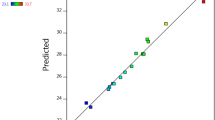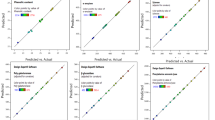Abstract
In this study, a high monacolin K yield was achieved through solid-state fermentation of Ginkgo biloba seeds. Monascus purpureus suspension made from red yeast rice was used as spore inoculum. Fermentation conditions in solid-state fermentation were optimized using response surface methodology, and the optimal conditions for the maximum monacolin K yield (17.71 ± 1.57 mg/g) were 0.22% ammonium sulfate, 0.34% ammonium chloride, 0.05% magnesium sulfate, fermentation time of 12 days, inoculation volume of 11%, and temperature of 27 °C. The total phenolic content of Monascus-fermented ginkgo seeds attained 9.67 mg GAE/g, 4.88-fold higher than that of unfermented ginkgo seeds. The scavenging abilities of DPPH and ABTS free radicals increased to 9.79 mg TE/g and 13.92 mg TE/g, respectively. These findings highlight the importance of investigating the optimal fermentation conditions for maximum monacolin K yield and the utilization value of ginkgo seed as fermentation substrate for higher bioactivities.


Similar content being viewed by others
Data availability
The datasets generated and/or analysed during the current study are not publicly available due data protection but are available from the corresponding author on reasonable request.
Code availability
This section is not applicable.
Abbreviations
- HMG-CoA:
-
3-Hydroxy-3-methyl glutaryl coenzyme A
- RSM:
-
Response surface methodology
- DPPH:
-
1,1-Diphenyl-2-picrylhydrazyl
- ABTS:
-
2,2-Azinobis(3-ethyl-benzothiazoline-6-sulfonic acid)
- Trolox:
-
6-Hydroxy-2,5,7,8-tetramethylchroman-2-carboxylic acid
- Rutin:
-
Quercetin-3-β-d-rutinoside
- PBD:
-
Plackett–Burman design
- BBD:
-
Box–Behnken design
- SAD:
-
Steepest ascent design
- TPC:
-
Total phenolic content
- TFC:
-
Total flavonoid content
- ANOVA:
-
Analysis of variance
- MFGS:
-
Monascus-fermented ginkgo seeds
- SS:
-
Sum of squares
- DF:
-
Degree of freedom
- MS:
-
Mean square
- SSE:
-
Sum of squares of effect
- SSF:
-
Solid-state fermentation
- CR:
-
Contribution rate
- GAE:
-
Gallic acid equivalent
- RE:
-
Rutin equivalent
- TE:
-
Trolox equivalent
References
Agboyibor C, Kong WB, Chen D, Zhang AM, Niu SQ. Monascus pigments production, composition, bioactivity and its application: A review. Biocatalysis and Agricultural Biotechnology. 16: 433-447 (2018)
Blois MS. Antioxidant determinations by the use of a stable free radical. Nature. 181: 1199-1200 (1958)
DeBose-Boyd RA. Feedback regulation of cholesterol synthesis: sterol-accelerated ubiquitination and degradation of HMG CoA reductase. Cell Research. 18: 609-619 (2008)
Feng YL, Shao YC, Zhou YX, Chen FS. Monacolin K production by citrinin-free Monascus pilosus MS-1 and fermentation process monitoring. Engineering in Life Sciences. 14: 538-545 (2014a)
Feng YL, Shao YC, Zhou YX, Chen FS. Production and optimization of monacolin K by citrinin-free Monascus pilosus MS-1 in solid-state fermentation using non-glutinous rice and soybean flours as substrate. European Food Research and Technology. 239: 629-636 (2014b)
Ghasemi Y, Mohkam M, Ghasemian A, Rasoul-Amini S. Experimental design of medium optimization for invertase production by Pichia sp. Journal of Food Science and Technology. 51: 267-275 (2014)
Ghosh S, Dam B. Genome shuffling improves pigment and other bioactive compound production in Monascus purpureus. Applied Microbiology and Biotechnology. 104: 10451-10463 (2020)
Guo N, Song XR, Kou P, Zang YP, Jiao J, Efferth T, Liu ZM, Fu YJ. Optimization of fermentation parameters with magnetically immobilized Bacillus natto on Ginkgo seeds and evaluation of bioactivity and safety. LWT - Food Science and Technology. 97: 172-179 (2018)
Guo N, Jiang YW, Song XR, Li YY, Liu ZM, Fu YJ. Effect of Bacillus natto solid-state fermentation on the functional constituents and properties of Ginkgo seeds. Journal of Food Biochemistry. 43: e12820 (2019)
Ho BY, Pan TM. The Monascus metabolite monacolin K reduces tumor progression and metastasis of Lewis lung carcinoma cells. Journal of Agricultural and Food Chemistry. 57: 8258-8265 (2009)
Hsu WH, Lee BH, Pan TM. Protection of Monascus-fermented dioscorea against DMBA-induced oral injury in hamster by anti-inflammatory and antioxidative potentials. Journal of Agricultural and Food Chemistry. 58: 6715-6720 (2010)
Jia J, Yang X, Wu Z, Zhang Q, Lin Z, Guo H, Lin CSK, Wang J, Wang Y. Optimization of fermentation medium for extracellular lipase production from Aspergillus niger using response surface methodology. BioMed Research International. 2015: 497462 (2015)
Lee SS, Lee JH, Lee I. Strain improvement by overexpression of the laeA gene in Monascus pilosus for the production of monascus-fermented rice. Journal of Microbiology and Biotechnology. 23: 959-965 (2013)
Li YG, Liu H, Wang ZT. A validated stability-indicating HPLC with photodiode array detector (PDA) method for the stress tests of Monascus purpureus-fermented rice, red yeast rice. Journal of Pharmaceutical and Biomedical Analysis. 39: 82-90 (2005a)
Li ZM, Zhang XL, Li HF, Zhang QQ. Comparison of ginkgo acid and total ginkgolic acid in different parts of ginkgo and different processed products. Chinese Medicine. 1: 164-168 (2005b)
Liu H, Zhang J, Lu G, Wang F, Shu L, Xu H, Li Z, Wang Y, Guo Q, Wu S, Jiang L, Wang C, Huang D, Liu B. Comparative metabolomics analysis reveals the metabolic regulation mechanism of yellow pigment overproduction by Monascus using ammonium chloride as a nitrogen source. Applied Microbiology and Biotechnology. 105: 6369-6379 (2021)
Liu X, Sun A, Li Q, Du Y, Zhao T. A systematic study of the production of Monacolin K by solid state fermentation of Monascus ruber. AMB Express. 12: 29 (2022)
Lu LP, Zhang BB, Xu GR. Efficient conversion of high concentration of glycerol to Monacolin K by solid-state fermentation of Monascus purpureus using bagasse as carrier. Bioprocess and Biosystems Engineering. 36: 293-299 (2013)
Molaverdi M, Karimi K, Mirmohamadsadeghi S, Galbe M. High titer ethanol production from rice straw via solid-state simultaneous saccharification and fermentation by Mucor indicus at low enzyme loading. Energy Conversion and Management. 182: 520-529 (2019)
Patakova P. Monascus secondary metabolites: production and biological activity. Journal of Industrial Microbiology & Biotechnology. 40: 169-181 (2013)
Puttananjaiah MH, Dhale MA, Govindaswamy V. Non-Toxic effect of Monascus purpureus extract on lactic acid bacteria suggested their application in fermented foods. Food and Nutrition Sciences. 02: 837-843 (2011)
Re R, Pellegrini N, Proteggente A, Pannala A, Yang M, Rice-Evans C. Antioxidant activity applying an improved ABTS radical cation decolorization assay. Free Radical Biology and Medicine. 26: 1231-1237 (1999)
Rosso L, Robinson TP. A cardinal model to describe the effect of water activity on the growth of moulds. International Journal of Food Microbiology. 63: 265-273 (2001)
Santos JS, Deolindo CTP, Hoffmann JF, Chaves FC, do Prado-Silva L, Sant'Ana AS, Azevedo L, do Carmo MAV, Granato D. Optimized Camellia sinensis var. sinensis, Ilex paraguariensis, and Aspalathus linearis blend presents high antioxidant and antiproliferative activities in a beverage model. Food Chemistry. 254: 348-358 (2018)
Seenivasan A, Subhagar S, Aravindan R, Viruthagiri T. Microbial production and biomedical applications of lovastatin. Indian Journal of Pharmaceutical Sciences. 70: 701-709 (2008)
Sehrawat R, Panesar PS, Swer TL, Kumar A. Response surface methodology (RSM) mediated interaction of media concentration and process parameters for the pigment production by Monascus purpureus MTCC 369 under solid state fermentation. Pigment & Resin Technology. 46: 14-20 (2017)
Seraman S, Rajendran A, Thangavelu V. Statistical optimization of anticholesterolemic drug lovastatin production by the red mold Monascus purpureus. Food and Bioproducts Processing. 88: 266-276 (2010)
So SS, Hwang TH, AKRAM W, Choi JK, Lee JJ. Insecticidal activities of Ginkgo biloba seed coat extracts against Spodoptera exigua (Lepidoptera: Noctuidae). Entomological Research. 42: 158-162 (2012)
Suraiya S, Kim JH, Tak JY, Siddique MP, Young CJ, Kim JK, Kong IS. Influences of fermentation parameters on lovastatin production by Monascus purpureus using Saccharina japonica as solid fermented substrate. LWT - Food Science and Technology. 92: 1-9 (2018)
Valík Lr, Piecková E. Growth modelling of heat-resistant fungi: the effect of water activity. International Journal of Food Microbiology. 63: 11-17 (2001)
Xiao G, Lyu M, Wang Y, He S, Liu X, Ni J, Li L, Fan G, Han J, Gao X, Wang X, Zhu Y. Ginkgo flavonol glycosides or ginkgolides tend to differentially protect myocardial or cerebral ischemia-reperfusion injury via regulation of TWEAK-Fn14 signaling in heart and brain. Frontiers in Pharmacology. 10: 735 (2019)
Xie Z, Wu X, Gong Y, Song Y, Qiu Q, Li C. Intraperitoneal injection of Ginkgo biloba extract enhances antioxidation ability of retina and protects photoreceptors after light-induced retinal damage in rats. Current Eye Research. 32: 471-479 (2007)
Zare H, Owlia P, Vahidi H, Hosseindokht KM. Simultaneous Optimization of the production of organic selenium and cell biomass in Saccharomyces cerevisiae by Plackett-Burman and Box-Behnken design. Iranian Journal of Pharmaceutical Research: IJPR. 17: 1081-1092 (2018)
Zhang W, He X, Liu H, Guo H, Ren F, Gao W, Wen P. Statistical optimization of medium components for milk-clotting enzyme production by Bacillus amyloliquefaciens D4 using wheat Bran-an agro-industry waste. Journal of Microbiology and Biotechnology. 23: 1084-1091 (2013a)
Zhang Z, Liu D, Feng F, Li J, Li M, Pang Q, Chen K. Optimization of the nutrition for biodegradation of vinasse by Aspergillus oryzae using response surface methodology. Water Science and Technology. 67: 772-779 (2013b)
Zhang BB, Xing HB, Jiang BJ, Chen L, Xu GR, Jiang Y, Zhang DY. Using millet as substrate for efficient production of monacolin K by solid-state fermentation of Monascus ruber. Journal of Bioscience and Bioengineering. 125: 333-338 (2018)
Acknowledgements
This work was supported by the North Jiangsu Science and Technology Project (XZ-sz201929) and the National Key R&D Program of China (2019YFD1002300); The authors thank to acknowledge the support of the priority academic program development (PAPD) of Jiangsu higher education institutions and co-innovation entre for sustainable forestry in southern China.
Funding
North Jiangsu Science and Technology Project (XZ-sz201929) and the National Key R&D Program of China (2019YFD1002300).
Author information
Authors and Affiliations
Contributions
ZW designed the study and drafted the manuscript. WM collected test data. YY designed the methods. GF designed and validated the study. CW designed the methods and analyzed the data. TL collected test data. CX designed the study. DS collected and analyzed the data.
Corresponding author
Ethics declarations
Conflict of interest
All authors of the article have no conflict of interest.
Ethical approval
This section is not applicable.
Consent for publication
This section is not applicable.
Consent to participate
This section is not applicable.
Additional information
Publisher's Note
Springer Nature remains neutral with regard to jurisdictional claims in published maps and institutional affiliations.
Supplementary Information
Below is the link to the electronic supplementary material.
Rights and permissions
About this article
Cite this article
Wu, Z., Miao, W., Yang, Y. et al. Preparation of Monascus-fermented ginkgo seeds: optimization of fermentation parameters and evaluation of bioactivity. Food Sci Biotechnol 31, 721–730 (2022). https://doi.org/10.1007/s10068-022-01078-z
Received:
Revised:
Accepted:
Published:
Issue Date:
DOI: https://doi.org/10.1007/s10068-022-01078-z




